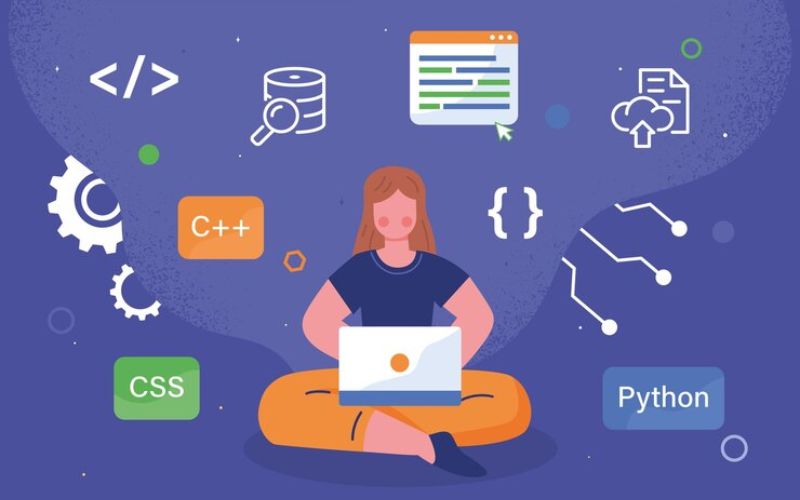Python, a highly versatile, famous and powerful programming language. It has recently experienced remarkable popularity among Python developers and businesses. Its appeal lies in its incredible simplicity, readability, and an extensive collection of libraries and frameworks. These factors combined make Python an attractive choice for various application development across different industries.
In this blog, we will explore the advantages of Python development and its various use cases, demonstrating its relevance and effectiveness across multiple domains.
The Top Advantages and Use Cases of Python Development
Here we will discuss the top advantages and use cases of Python development so you can get an idea about it and get a good ROI for your business.
Quick Intro to Python
Python, founded by Guido van Rossum in 1991, is renowned for its simplicity and readability in the programming world. Its emphasis on clarity doesn’t compromise its creative potential. Python’s code is not just instructions; it’s a narrative, weaving complexity and bursts of creativity together. It stands as a beacon of lucidity in the intricate realm of programming, inviting both beginners and seasoned developers to explore its mysteries.
Advantages of Python Development
Now let’s discuss the advantages of Python development. The advantages show how you can hire dedicated Python developers to develop a product that gets excellent ROI.
Easy-to-Read and Write Code
Python is celebrated for its syntax that is user-friendly, meticulously crafted for easy readability and expressiveness. In contrast to certain other programming languages, Python empowers developers to articulate intricate ideas using minimal lines of code.
A pivotal factor enhancing its readability lies in Python’s utilization of indentation and whitespace to delineate code blocks. This methodology not only amplifies code lucidity but also minimizes the likelihood of syntax errors. With Python, developers can create succinct, aesthetically pleasing, and effortlessly comprehensible code.
Extensive Library Support
Python’s strongness shines through its extensive collection of libraries and frameworks. It covers a spectrum of domains including web development, data analysis, and machine learning. These libraries offer a huge treasure of pre-built modules and functions, empowering developers to leverage existing solutions and accelerate their development workflows.
Platform Independence
Python is a versatile language that operates seamlessly across various operating systems, including Windows, macOS, and Linux, without necessitating extensive code adjustments. This cross-platform compatibility empowers Python developers to compose code once and deploy it across different environments, thereby diminishing development time and workload.
Scalability and Flexibility: Python’s Universal Charm
Python stands tall as a beacon of scalability and flexibility, offering developers the canvas to craft projects of any magnitude. Whether sculpting a concise script or architecting a multifaceted application, Python gracefully accommodates diverse project needs. Its universal appeal lies in this adaptability, making it the language of choice for developers traversing varied terrains of creativity.
Rapid Development: Where Ideas Transmute into Reality
The simplicity inherent in Python becomes the launchpad for rapid application development. Its lucid syntax, coupled with an extensive library ecosystem, empowers developers to breathe life into concepts swiftly. Prototyping ideas, testing hypotheses, and refining solutions become seamless endeavors, ushering startups and businesses into a realm of agility. In the race to market, Python emerges as the trusted steed, galloping ahead with speed and precision.
Integration Capabilities for Python Developers: Bridging Language Barriers
Python boasts a unique prowess: the ability to seamlessly integrate with diverse languages and systems. This interoperability makes Python a linchpin in building scalable and interconnected applications. By harmoniously intertwining with languages like C, C++, and Java, Python enables developers to harness existing code and infrastructure. In this collaborative symphony, Python dances fluidly, connecting disparate elements into a harmonious whole.
Strong Community Support: A Pillar of Reliability
At the heart of Python’s resilience resides its vibrant community—a congregation of passionate developers fueling its growth. This collective intelligence ensures a continuous stream of enhancements, bug fixes, and a treasure trove of resources. Within this community-driven crucible, developers find solace, solutions, and a perpetual wellspring of knowledge. Be it unraveling complexities or embracing innovations, the Python community stands as an unwavering lighthouse.
Open-Source Nature: Fostering Innovation
Python’s open-source ethos ushers in an era of collaboration and innovation. Its freely accessible source code becomes a playground for developers, fostering a culture of collective creativity. This openness sparks collaborations, births innovative tools, and nurtures a rich ecosystem of frameworks and libraries. In this borderless landscape, ideas flow freely, pushing the boundaries of what Python can achieve.
Data Analysis and Machine Learning
In the world of data analysis and machine learning, Python emerges as a torchbearer, guiding researchers and practitioners through uncharted territories. Libraries such as NumPy, Pandas, SciPy, Scikit-learn, and TensorFlow empower developers with robust tools. From data manipulation and scientific computing to crafting intricate machine learning models, Python’s simplicity harmonizes with the sophistication of these libraries.
Web Development: Crafting Digital Experiences
Python’s prowess extends to the digital realm, where frameworks like Django and Flask come to life. Django, a stalwart in web development, stands as a testament to comprehensive features. Its model-view-controller architecture, coupled with object-relational mapping and robust security measures, delivers a holistic web development experience. On the other end, Flask’s lightweight elegance caters to the minimalist’s soul, providing essential components for web applications without unnecessary constraints.
Python Development Use Cases – Web Development
Django: Full-Featured Web Framework
Django is a popular Python web framework known for its batteries-included approach. It delivers complete tools and features for building complex web applications. Django follows the MVC pattern and offers features like object-relational mapping (ORM), user authentication, an admin interface, and built-in security measures.
Flask: Lightweight Web Framework
Flask is a minimalistic and lightweight web framework focusing on simplicity and extensibility. It provides the essentials for web development without imposing too many constraints. Flask allows Successful Python developers to choose the necessary libraries and components, making it flexible for small to medium-sized web applications.
Python Development Use Cases – Data Analysis and Machine Learning
NumPy: Numerical Computing Library
NumPy serves as a powerful library for scientific computing in Python. It provides extensive support for handling large-scale, multi-dimensional arrays and matrices and a comprehensive set of mathematical functions designed to manipulate these arrays efficiently. Due to its capabilities, NumPy finds extensive usage in various domains, such as data analysis, numerical simulations, and diverse scientific applications.
Pandas: Data Manipulation Library
Pandas is a prevailing library for data manipulation and analysis. It offers data structures like DataFrame and Series, which facilitate data cleaning, transformation, and exploration. Pandas are extensively used in data preprocessing, wrangling, and visualization tasks.
SciPy: Scientific Computing Library
SciPy is a powerful Python library that is a comprehensive scientific computing tool. It extends the capabilities of NumPy and offers additional features for optimization, integration, linear algebra, signal processing, and more. SciPy plays a crucial role in scientific research, engineering simulations, and data analysis, making it an invaluable resource in these fields.
Scikit-learn: Machine Learning Library
Scikit-learn stands tall as a beacon of knowledge. This ubiquitous library offers a plethora of algorithms, a treasure trove for tasks ranging from cataloging to regression, from clustering to dimensionality reduction. Its allure lies not just in its extensive algorithmic arsenal but also in its intuitive and user-friendly API.
Seamlessly intertwining with other Python libraries, Scikit-learn emerges as the veritable choice for discerning machine learning enthusiasts. Its versatility echoes through projects, its ease of use reverberates across industries, making it the undisputed champion in the realm of machine learning.
TensorFlow: Deep Learning Library
In the labyrinthine world of deep learning, TensorFlow reigns supreme, an open-source colossus empowering developers to craft neural networks of unparalleled sophistication. This influential library transcends conventional boundaries, enabling the construction and training of neural networks for a myriad of tasks.
From the intricate realms of image recognition to the nuances of Natural Language Processing (NLP), from deciphering complex time series to delving into the intricacies of quantum mechanics, TensorFlow’s prowess knows no bounds. Its flexibility dances in harmony with its scalability, rendering it the ultimate choice for both research pursuits and industrial applications.
Python Development Use Cases – Automation and Scripting
Python’s user-friendly nature positions it as an ideal option for automation and scripting endeavors. Be it automating repetitive tasks, handling system resources, or crafting scripts for system administration, Python provides a rich array of tools and libraries to simplify these operations.
Other Python Development Use Cases:
- Artificial Intelligence and Natural Language Processing
- Internet of Things (IoT) Applications
- Game Development
- Finance and Quantitative Analysis
- DevOps and Infrastructure Automation
- Big Data and Data Engineering
- And more…
Famous Apps Developed by Successful Python Developers
Here is a list of known apps created by Python.
- Dropbox
- Spotify
- Netflix
- Quora
Final Snippets
In short, the power of Python developers is undeniable, and harnessing their expertise can bring immense benefits to your projects. If you’re looking for the best, valuable and skilled Python development company to unlock the full potential of this universal language, look no further.
FAQs
Q1: What is Python, and why is it so popular among developers?
Python is a popular, easy-to-understand programming language used for tasks like web development, data analysis, and machine learning. It’s favored for its simplicity, extensive libraries, and adaptability.
Q2: What are the advantages of using Python for software development?
Python’s benefits include simplicity, quick development, and easy maintenance. It supports multiple programming styles and has a rich ecosystem of tools, enhancing productivity.
Q3: What are the typical use cases for Python?
Python is used for web development, scientific computing, data analysis, machine learning, and artificial intelligence. Its versatility suits various applications, from building websites to complex data modeling.
Q4: Can Python be used for both small and large-scale projects?
Yes, Python is suitable for both small and large-scale projects due to its simplicity for small tasks and scalability for complex applications. It’s a versatile tool used in a wide range of projects.


